Arkansas State University - Beebe Nursing Programs
Arkansas State University - Beebe is a public institution located in Beebe, Arkansas. Beebe is a great place for students who enjoy small town life.
Where Is Arkansas State University - Beebe?

Contact details for ASU-Beebe are given below.
| Contact Details | |
|---|---|
| Address: | 1000 Iowa Street, Beebe, AR 72012-1000 |
| Phone: | 501-882-3600 |
| Website: | www.asub.edu |
How Do I Get Into ASU-Beebe?
You can apply to ASU-Beebe online at: www.asub.edu/admissions/index.aspx
Can I Afford Arkansas State University - Beebe?
Student Loan Debt
While almost two-thirds of students nationwide take out loans to pay for college, the percentage may be quite different for the school you plan on attending. At ASU-Beebe, approximately 9% of students took out student loans averaging $4,435 a year. That adds up to $17,740 over four years for those students.
Arkansas State University - Beebe Undergraduate Student Diversity

Gender Diversity
Of the 1,550 full-time undergraduates at ASU-Beebe, 37% are male and 63% are female.

Racial-Ethnic Diversity
The racial-ethnic breakdown of Arkansas State University - Beebe students is as follows.

| Race/Ethnicity | Number of Grads |
|---|---|
| Asian | 17 |
| Black or African American | 89 |
| Hispanic or Latino | 84 |
| White | 1,284 |
| International Students | 1 |
| Other Races/Ethnicities | 75 |
Over 11 countries are represented at ASU-Beebe. The most popular countries sending students to the school are El Salvador, Tanzania, and Vietnam.
Arkansas State University - Beebe Nursing Concentrations
The table below shows the number of awards for each concentration.
| Major | Basic Certificate | Associate’s | Undergraduate Certificate | TOTAL |
|---|---|---|---|---|
| Nursing Assistant/Aide and Patient Care Assistant/Aide | 36 | 0 | 0 | 36 |
| Licensed Practical/Vocational Nurse Training | 0 | 0 | 24 | 24 |
| Registered Nursing | 0 | 8 | 0 | 8 |
| TOTAL | 36 | 8 | 24 | 68 |
References
*The racial-ethnic minorities count is calculated by taking the total number of students and subtracting white students, international students, and students whose race/ethnicity was unknown. This number is then divided by the total number of students at the school to obtain the racial-ethnic minorities percentage.
More about our data sources and methodologies.
